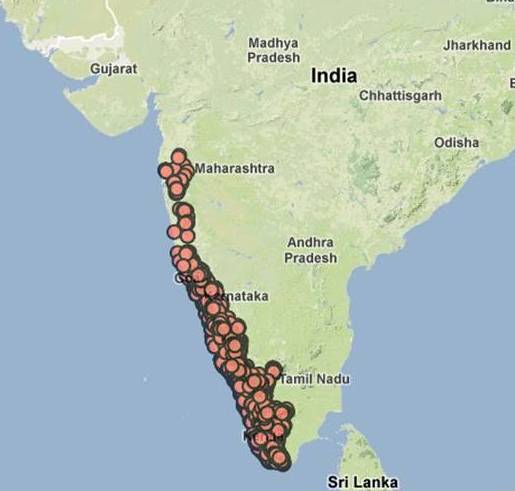
Biodiversity information management using informatics techniques began in 1970s and since then there have been several initiatives by taxonomists, researchers and curators across the world.
On 19 and 20 January 2013, the city of Bangalore hosted researchers in biodiversity informatics, taxonomists, herbarium managers and curators, representatives from biodiversity portal initiatives and young graduate students, in a workshop that examined advances in information technology that enable open, net-based access to India’s biodiversity information.
The workshop titled “Indo–US Biodiversity Informatics”, was organized by ATREE, Bangalore in collaboration with India Biodiversity Portal (IBP), Encyclopedia of Life (EOL), the Western Ghats Portal (WGP) and Strand Life Sciences.
India Biodiversity Portal (IBP) was launched in 2008 by ATREE and its partners, to establish an open access biodiversity information platform for India. It has features such as a map module, species module and a citizen science module. The Portal was designed to facilitate user interaction and participation.
The Encyclopedia of Life (EOL) was also launched in 2008 to provide access to information on every species in the world. EOL is a significant global resource for descriptive information about living organisms. It has built collaborations and partnerships with similar initiatives around the world.
What is biodiversity informatics ?
Biodiversity informatics is the application of informatics techniques to biodiversity information for management, presentation and analysis. It typically builds on a foundation of taxonomic information stored in digital form which is useful for viewing, analysis and for predictive modelling.
Biodiversity informatics began in 1970s with the first computerisation of taxonomy database in the US. This progressed further in 1990s with the development of search tools in 1990s including the Species Analyst from Kansas University, the North American Biodiversity Information Network NABIN, CONABIO in Mexico and others. Later in 2004, the journal "Biodiversity Informatics" commenced its publication. Several international conferences through the 2000s, have brought together biodiversity informatics practitioners across the world.
Some major issues in biodiversity informatics
Though the field of biodiversity informatics is nearly 4 decades old, there are several issues that are still worrying taxonomists all over the world. One major issue is that of absence of a comprehensive master list of recognized species of the world in real time. Another is of multiple representations of same species including spelling errors. The issue of achieving a consensus on the classification of an organism is another very big issue which is causing problems in biodiversity informatics system design. Much of the data comes from primary sources such as surveys conducted by professionals, students and amateurs. Mobilising this primary data regarding the distribution of species in time and space is a difficult task.
Summary of important workshop sessions
The workshop presented some very interesting initiatives both from the government of India as well as research community in the country on developing species pages, streamlining taxonomy and so on.
Dr. Venkataraman from the Zoological Survey of India who was one of the speakers at the workshop, presented the biological diversity of India from past literature, museum records and other lesser popular/ limited access sources of information

Map showing the distribution of endemic (local) tree species in Western Ghats, India (Image courtesy: www.indiabidiversityportal.org)
Dr. Sameer from the Indian Institute of Remote Sensing, Dehradun presented the Indian Bio-Resource Information Network (IBIN) programme of the Department of Biotechnology, GoI, being implemented in collaboration with University of Agricultural Sciences (UAS) and Indian Institute of Remote Sensing (IIRS). This programme provides data on specialized topics and is being collected and collated by different partners across the country, such as medicinal plants (UAS), maps and checklists (ATREE), chromozome data (Kolkata University) etc. The model works on integration of work being done by others by bringing them on board as collaborators.
Dr. Binay Panda from Ganit Labs presented on how DNA bar-coding is effective in identification of species and how this is replacing the traditional morphology-based methodology.
Even with all these issues being faced by this field / sector, there has been significant advancement in this field. The workshop served as a good reflection point on the current status of biodiversity mapping in India and in the United States of America.
Interested ?
If you are interested in biodiversity conservation or if you are an amateur taxonomist, then you can be a part of some of these initiatives. Here's one way you can get started.
/articles/biodiversity-informatics-india-birds-eye-view